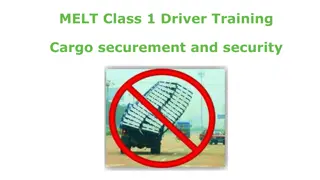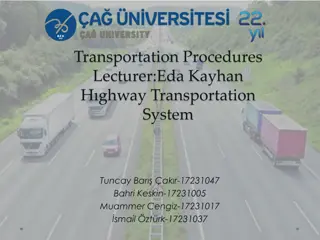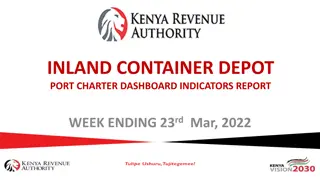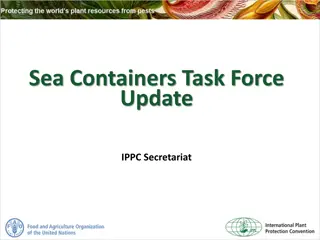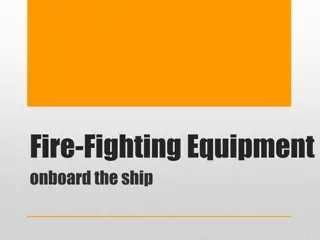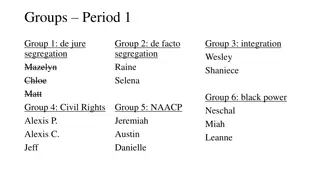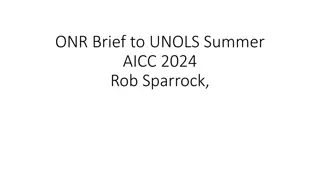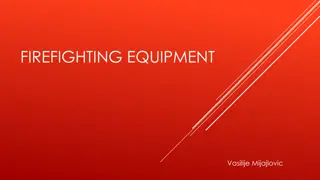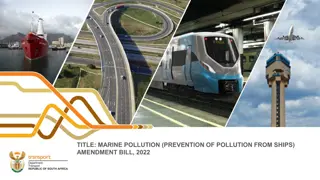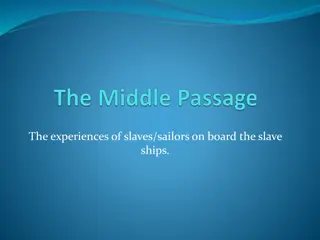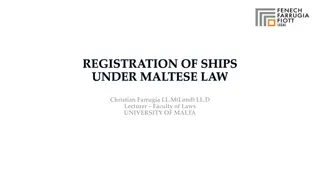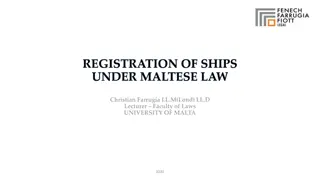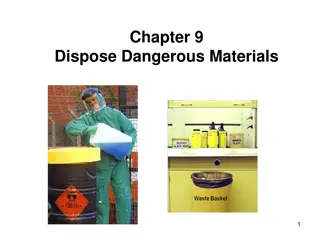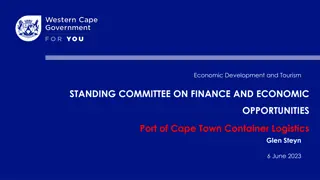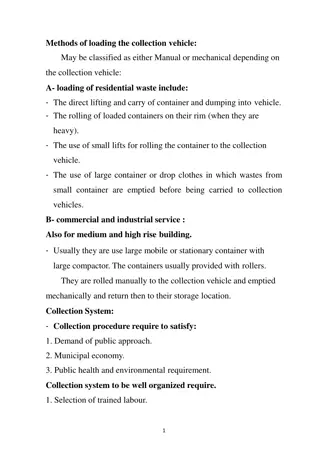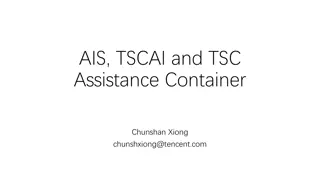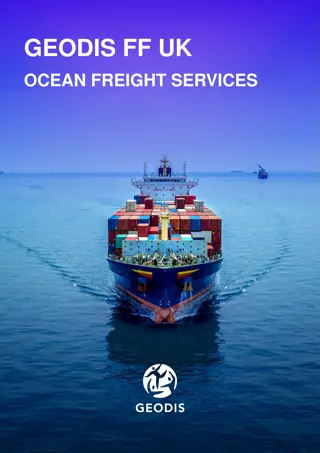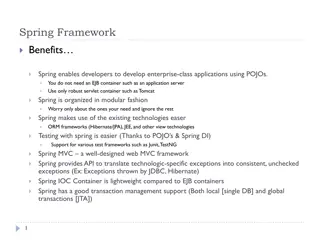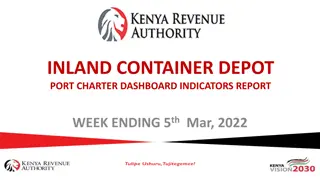Proper Stowage and Segregation of Dangerous Cargo on Container Ships
Exercise caution when stowing dangerous cargo on board container ships. Ensure compliance with international regulations, IMDG code guidance, and vessel-specific requirements. Verify stowage and segregation of dangerous goods, manually check for compliance, and adhere strictly to segregation requirements. Be aware of individual entries in the IMDG code for specific stowage requirements. Caution when using stowage planning software for verification.
Uploaded on Sep 11, 2024 | 0 Views
Download Presentation

Please find below an Image/Link to download the presentation.
The content on the website is provided AS IS for your information and personal use only. It may not be sold, licensed, or shared on other websites without obtaining consent from the author. Download presentation by click this link. If you encounter any issues during the download, it is possible that the publisher has removed the file from their server.
E N D
Presentation Transcript
DG Stowage & Segregation for Container ships 1 1- -Particular caution is to be exercised when stowing dangerous cargo on board Particular caution is to be exercised when stowing dangerous cargo on board the vessel. the vessel. Any dangerous cargo presented for loading must be accompanied by a Any dangerous cargo presented for loading must be accompanied by a proper manifest and declaration as required by international regulations . proper manifest and declaration as required by international regulations . 2 2- -Further this DG cargo must be acceptable for carriage as per IMDG code guidance. Further this DG cargo must be acceptable for carriage as per IMDG code guidance. Reference here is made to the list of UN numbers restricted/prohibited for carriage Reference here is made to the list of UN numbers restricted/prohibited for carriage on board particular vessels. on board particular vessels. 3 3- -After confirming acceptability of the DG cargo, the plan must be checked for After confirming acceptability of the DG cargo, the plan must be checked for proper stowage and segregation. Although terminal and central planners should proper stowage and segregation. Although terminal and central planners should provide proper stow of DG cargo, the final responsibility always lies with the Master. provide proper stow of DG cargo, the final responsibility always lies with the Master. 4 4- -Reference shall be made to vessels Document of Compliance with special Reference shall be made to vessels Document of Compliance with special requirements for ships carrying dangerous goods for confirming that proposed DG requirements for ships carrying dangerous goods for confirming that proposed DG classes are acceptable for stowage in planned locations on board. classes are acceptable for stowage in planned locations on board.
5 5- -Specific stowage requirements for DG cargo Specific stowage requirements for DG cargo (e.g. Clear of living quarters OR if under deck, in a mechanically ventilated space (e.g. Clear of living quarters OR if under deck, in a mechanically ventilated space etc may be verified from individual entries of dangerous goods list in the IMDG code. may be verified from individual entries of dangerous goods list in the IMDG code. etc) ) 6 6- -DG segregation shall be verified for compliance with requirements of the IMDG code. DG segregation shall be verified for compliance with requirements of the IMDG code. Caution must be exercised when using vessels stowage planning software for this Caution must be exercised when using vessels stowage planning software for this purpose as it may or may not have comprehensive means of checking for bad purpose as it may or may not have comprehensive means of checking for bad stowage & segregation against the latest international requirements. stowage & segregation against the latest international requirements. It is advisable to manually check for compliance. It is advisable to manually check for compliance. Segregation requirements of the IMDG code and any other local/national regulations Segregation requirements of the IMDG code and any other local/national regulations must be strictly adhered to. must be strictly adhered to. One must be aware that even DG cargoes belonging to the same class may have One must be aware that even DG cargoes belonging to the same class may have segregation requirements amongst them. segregation requirements amongst them. A good example is that of alkalis requiring to be separated form acids where as both A good example is that of alkalis requiring to be separated form acids where as both acids and alkalis may belong to IMO Class 8. Such segregation requirement will not acids and alkalis may belong to IMO Class 8. Such segregation requirement will not be found in the segregation tables of the IMDG code and only individual entries of the be found in the segregation tables of the IMDG code and only individual entries of the dangerous goods list in the code indicate the requirement dangerous goods list in the code indicate the requirement
Case Case study study on on the the port of Tianjin port of Tianjin explosion explosion Operations at two container terminals in the port of Tianjin have been suspended following the Operations at two container terminals in the port of Tianjin have been suspended following the massive blast at the dangerous goods warehouse. massive blast at the dangerous goods warehouse. Three other container terminals all located between 3 to 8 miles from the latter Tianjin facility Three other container terminals all located between 3 to 8 miles from the latter Tianjin facility where the explosion occurred were confirmed to have been shut down immediately where the explosion occurred were confirmed to have been shut down immediately The explosions of the dangerous materials were located in the Bonded Area of Tianjin port The explosions of the dangerous materials were located in the Bonded Area of Tianjin port and caused by a badly stored shipment of explosives of 24 tons of TNT. and caused by a badly stored shipment of explosives of 24 tons of TNT. THE CONSEQUENCES ARE THE CONSEQUENCES ARE - 52 people were killed 40 on terminal +12 fire fighter 52 people were killed 40 on terminal +12 fire fighter - -700 people injured and intoxicated by the fumes of the toxic cloud 700 people injured and intoxicated by the fumes of the toxic cloud - -Several thousands of cars were completely destroyed Several thousands of cars were completely destroyed - -Series of containers were also destroyed Series of containers were also destroyed - -The goods that were in the containers were also completely destroyed The goods that were in the containers were also completely destroyed - -Buildings were damaged and destroyed Buildings were damaged and destroyed - -The terminal equipment has been declared total loss The terminal equipment has been declared total loss - -It also caused a environmental problem because of the fumes that It also caused a environmental problem because of the fumes that were dangerous for human life when inhaled. were dangerous for human life when inhaled. - -Some of the container vessels that were on the terminal also were damaged Some of the container vessels that were on the terminal also were damaged All the parties involved will now be very concerned on how the claims will be settled. All the parties involved will now be very concerned on how the claims will be settled. The carriers The carriers- -shippers shippers- -owners of the cargo are very concerned about the whole situation which owners of the cargo are very concerned about the whole situation which will cause a situation where a record amount of multi million dollar claims which will need to be will cause a situation where a record amount of multi million dollar claims which will need to be settled over a period of several years. settled over a period of several years.
THE REASONS THE CASTROPHY THE REASONS THE CASTROPHY 1 1- -Badly stored sodium cyanide 700 tons highly flammable and very dangerous Badly stored sodium cyanide 700 tons highly flammable and very dangerous 2 2- -When the first explosions occurred When the first explosions occurred - -It was unclear what chemicals were kept on site It was unclear what chemicals were kept on site - -Officials panicked and did not have the lists handy on what Officials panicked and did not have the lists handy on what products and IMCO classes were stored on site. products and IMCO classes were stored on site. - -There was a high degree of panic, people did not know what to do There was a high degree of panic, people did not know what to do 3 3- -The documentation of the warehouse concerned the dangerous goods was The documentation of the warehouse concerned the dangerous goods was not kept up to date and was not available to the fire fighters or the authorities not kept up to date and was not available to the fire fighters or the authorities 4 4- -The port and terminal were not prepared enough to confront a major incident The port and terminal were not prepared enough to confront a major incident like this and did not have access quickly enough to the data and equipment like this and did not have access quickly enough to the data and equipment to be able and contain or reduce the impact of the situation. to be able and contain or reduce the impact of the situation. 5 5- -Chemical experts were sent to assess the scene they could not be informed about the other range of chemical products that were stored and could not evaluate if the mix of products could trigger a serial explosion or not and what the immediate consequences would be for human life.
THE LESSONS 1-Train your staff and workers in the CFS and on the terminal 2-Follow the international guidelines IMDG-IMCO 3-Organize and plan the segregation in the CFS and Terminal and issue strict and procedures and maintain them by controlling regularly if these are maintained. 4-Keep the data of the type of DG products of the CFS warehouse at close range and insist that there is a second stock report and lay out of the segregation plan on hand outside the CFS and terminal. 5-Make sure that there is sufficient fire fighting equipment and medical supplies that are close to the area s where the DG is stored and are immediately available. 6-Also put IMDG signs and warning placards on the doors and walls of the CFS and on certain terminal area s where DG are kept in containers. 7-Insist on the fact that one does not allow any cargo on terminal or CFS without having detailed information on the content of the trucks or containers. 8-Pay attention to containers that arrive at your terminals in damaged condition or have leakage or are without valid ACEP or CSC plates. 9-Hold regular training exercises. 10-Also link up with the hospitals and authorities that are in the vicinity of your area and operations and also try to involve these during the training sessions.
DG Stowage & Segregation for Container ships 1 1- -Particular caution is to be exercised when stowing dangerous cargo on board Particular caution is to be exercised when stowing dangerous cargo on board the vessel. the vessel. Any dangerous cargo presented for loading must be accompanied by a Any dangerous cargo presented for loading must be accompanied by a proper manifest and declaration as required by international regulations . proper manifest and declaration as required by international regulations . 2 2- -Further this DG cargo must be acceptable for carriage as per IMDG code guidance. Further this DG cargo must be acceptable for carriage as per IMDG code guidance. Reference here is made to the list of UN numbers restricted/prohibited for carriage Reference here is made to the list of UN numbers restricted/prohibited for carriage on board particular vessels. on board particular vessels. 3 3- -After confirming acceptability of the DG cargo, the plan must be checked for After confirming acceptability of the DG cargo, the plan must be checked for proper stowage and segregation. Although terminal and central planners should proper stowage and segregation. Although terminal and central planners should provide proper stow of DG cargo, the final responsibility always lies with the Master. provide proper stow of DG cargo, the final responsibility always lies with the Master. 4 4- -Reference shall be made to vessels Document of Compliance with special Reference shall be made to vessels Document of Compliance with special requirements for ships carrying dangerous goods for confirming that proposed DG requirements for ships carrying dangerous goods for confirming that proposed DG classes are acceptable for stowage in planned locations on board. classes are acceptable for stowage in planned locations on board.
5 5- -Specific stowage requirements for DG cargo Specific stowage requirements for DG cargo (e.g. Clear of living quarters OR if under deck, in a mechanically ventilated space (e.g. Clear of living quarters OR if under deck, in a mechanically ventilated space etc may be verified from individual entries of dangerous goods list in the IMDG code. may be verified from individual entries of dangerous goods list in the IMDG code. etc) ) 6 6- -DG segregation shall be verified for compliance with requirements of the IMDG code. DG segregation shall be verified for compliance with requirements of the IMDG code. Caution must be exercised when using vessels stowage planning software for this Caution must be exercised when using vessels stowage planning software for this purpose as it may or may not have comprehensive means of checking for bad purpose as it may or may not have comprehensive means of checking for bad stowage & segregation against the latest international requirements. stowage & segregation against the latest international requirements. It is advisable to manually check for compliance. It is advisable to manually check for compliance. Segregation requirements of the IMDG code and any other local/national regulations Segregation requirements of the IMDG code and any other local/national regulations must be strictly adhered to. must be strictly adhered to. One must be aware that even DG cargoes belonging to the same class may have One must be aware that even DG cargoes belonging to the same class may have segregation requirements amongst them. segregation requirements amongst them. A good example is that of alkalis requiring to be separated form acids where as both A good example is that of alkalis requiring to be separated form acids where as both acids and alkalis may belong to IMO Class 8. Such segregation requirement will not acids and alkalis may belong to IMO Class 8. Such segregation requirement will not be found in the segregation tables of the IMDG code and only individual entries of the be found in the segregation tables of the IMDG code and only individual entries of the dangerous goods list in the code indicate the requirement dangerous goods list in the code indicate the requirement
The MSC FLAMINIA INCIDENT The MSC FLAMINIA INCIDENT The 300 meter ship had been on its way from Charleston in the United States to the German The 300 meter ship had been on its way from Charleston in the United States to the German port of Bremerhaven after stops in port of Bremerhaven after stops in Felixstowe Felixstowe, Suffolk, and Antwerp in Belgium. , Suffolk, and Antwerp in Belgium. An explosion occurred on the ship on July 14, about 300 nautical miles off the British coast, An explosion occurred on the ship on July 14, about 300 nautical miles off the British coast, resulting in the death of one crew member while another remains missing. resulting in the death of one crew member while another remains missing. The 23 people on board abandoned the ship and were picked up by an oil tanker. The 23 people on board abandoned the ship and were picked up by an oil tanker. German authorities have said the ship had 2,876 containers on board at the time of the German authorities have said the ship had 2,876 containers on board at the time of the explosion, of which 151 held flammable cleaning fluids. explosion, of which 151 held flammable cleaning fluids. The stricken MSC The stricken MSC Flaminia in the Atlantic Ocean after an explosion left a crewman dead and caused extensive damage to in the Atlantic Ocean after an explosion left a crewman dead and caused extensive damage to the vessel. the vessel. It was due to be towed to Germany after limping around international waters since early July. It was due to be towed to Germany after limping around international waters since early July. After it was established that there were 149 containers on board the 86,000 ton vessel that After it was established that there were 149 containers on board the 86,000 ton vessel that were classed as hazardous, corrosive or flammable it was clear that the number of the were classed as hazardous, corrosive or flammable it was clear that the number of the containers with dangerous goods seems to be unusually high and that many of them were containers with dangerous goods seems to be unusually high and that many of them were classed generally classed generally as NOS as NOS NOT OTHERWISE SPECIFIED which meant that little or no correct and complete NOT OTHERWISE SPECIFIED which meant that little or no correct and complete DG information was made available to the terminal and the vessel that loaded the containers. DG information was made available to the terminal and the vessel that loaded the containers. Flaminia, described as a floating bomb , has been burning for seven weeks , described as a floating bomb , has been burning for seven weeks Among its contents were liquid polychlorinated biphenyls [PCBs], the pesticide isopropyl Among its contents were liquid polychlorinated biphenyls [PCBs], the pesticide isopropyl amine, nitromethane, a very explosive amine, nitromethane, a very explosive fuel,phosphorus,liquid fuel,phosphorus,liquid amines and sodium. Having all these chemicals on board the vessel became a toxic and dangerous floating bomb. Having all these chemicals on board the vessel became a toxic and dangerous floating bomb. No wonder that the EU countries in the incident area feared the MSC No wonder that the EU countries in the incident area feared the MSC Flaminia was just short of being an explosive nuclear device. was just short of being an explosive nuclear device. amines and sodium. Flaminia because she because she
Initially the British authorities had refused to allow Dutch, British and Italian tug skippers to tow Initially the British authorities had refused to allow Dutch, British and Italian tug skippers to tow The vessel through British coastal waters until such a time an assessment was completed on board The vessel through British coastal waters until such a time an assessment was completed on board of the vessel to examine the hot spots in the holds by an international six of the vessel to examine the hot spots in the holds by an international six- -man team of inspectors. It became clear that there were 37 containers on board the ship that could be a serious risk for the It became clear that there were 37 containers on board the ship that could be a serious risk for the environment and together with the 1,247 tons of heavy crude oil and 680 tons of diesel on board the environment and together with the 1,247 tons of heavy crude oil and 680 tons of diesel on board the accident was potentially an enormous environmental disaster. accident was potentially an enormous environmental disaster. man team of inspectors. The authorities of the neighboring countries and the environmental groups have expressed outrage The authorities of the neighboring countries and the environmental groups have expressed outrage at the slowness of the response and actions to this emergency situation but this was due to the fact at the slowness of the response and actions to this emergency situation but this was due to the fact that one firstly had to gather all relevant details on the cargoes and inspect the vessel before it that one firstly had to gather all relevant details on the cargoes and inspect the vessel before it could be towed to a port. could be towed to a port. THE LESSONS TO BE LEARNED THE LESSONS TO BE LEARNED Are the same as in the previous Case Study , but again it is striking to see that even in very Are the same as in the previous Case Study , but again it is striking to see that even in very sophisticated ports were one has all the means that are required to handle and document sophisticated ports were one has all the means that are required to handle and document all DG containers it is not watertight and incidents can occur. all DG containers it is not watertight and incidents can occur. This is not to say that there should be a tolerance , to the contrary it is a warning to us all that This is not to say that there should be a tolerance , to the contrary it is a warning to us all that one has to implement ridged safety precautions to make sure none of such hazardous cargoes one has to implement ridged safety precautions to make sure none of such hazardous cargoes can pass through unless the required DG information is transmitted and available to all parties can pass through unless the required DG information is transmitted and available to all parties that need it or risk to have a need for these. that need it or risk to have a need for these. So never be self assured that all is fine and honky dory and that your organization requires So never be self assured that all is fine and honky dory and that your organization requires to be attentive all the time. to be attentive all the time.



